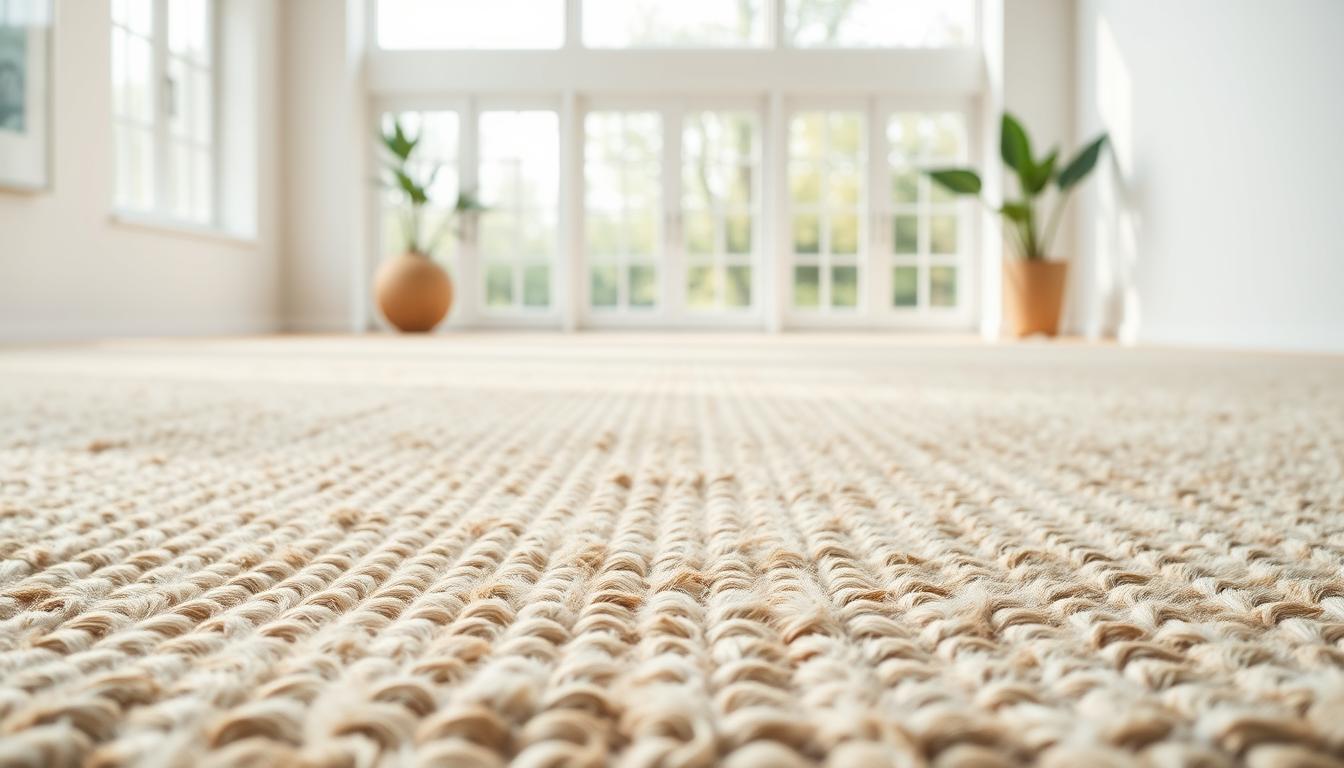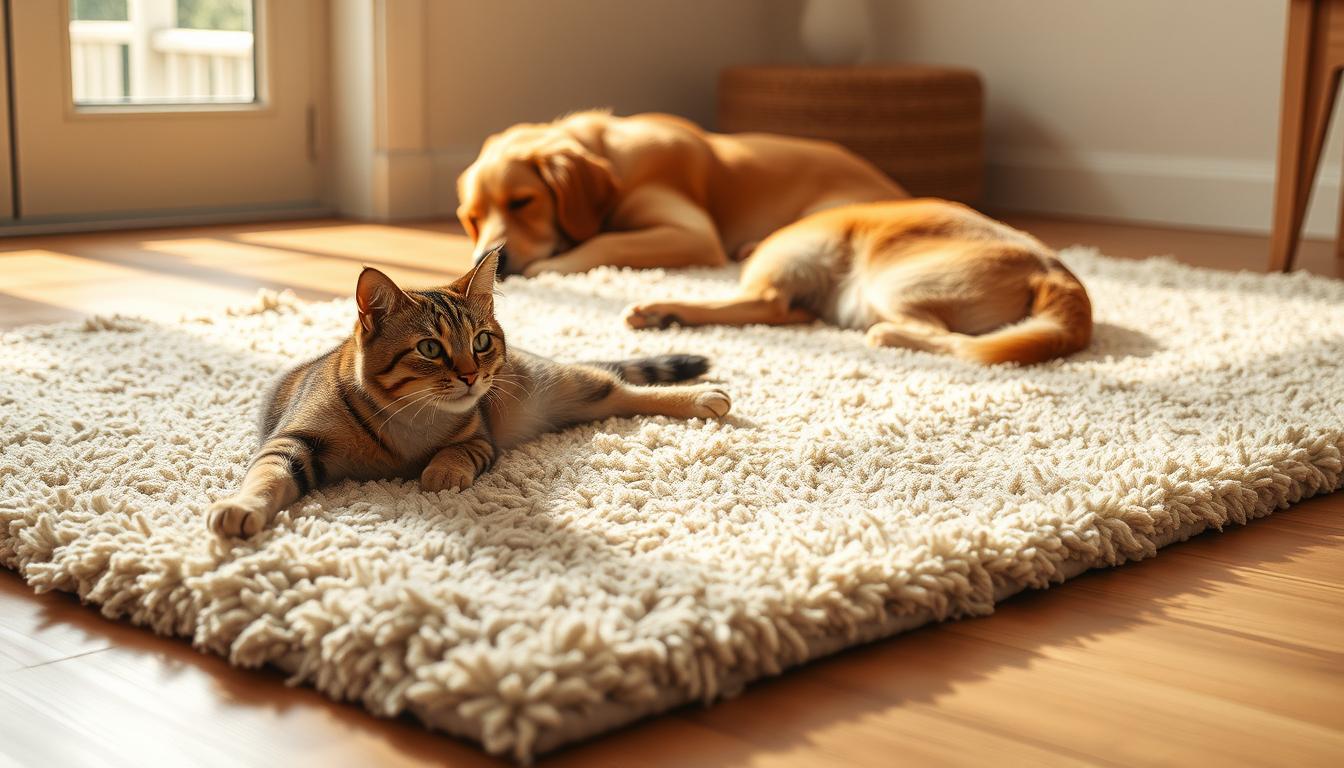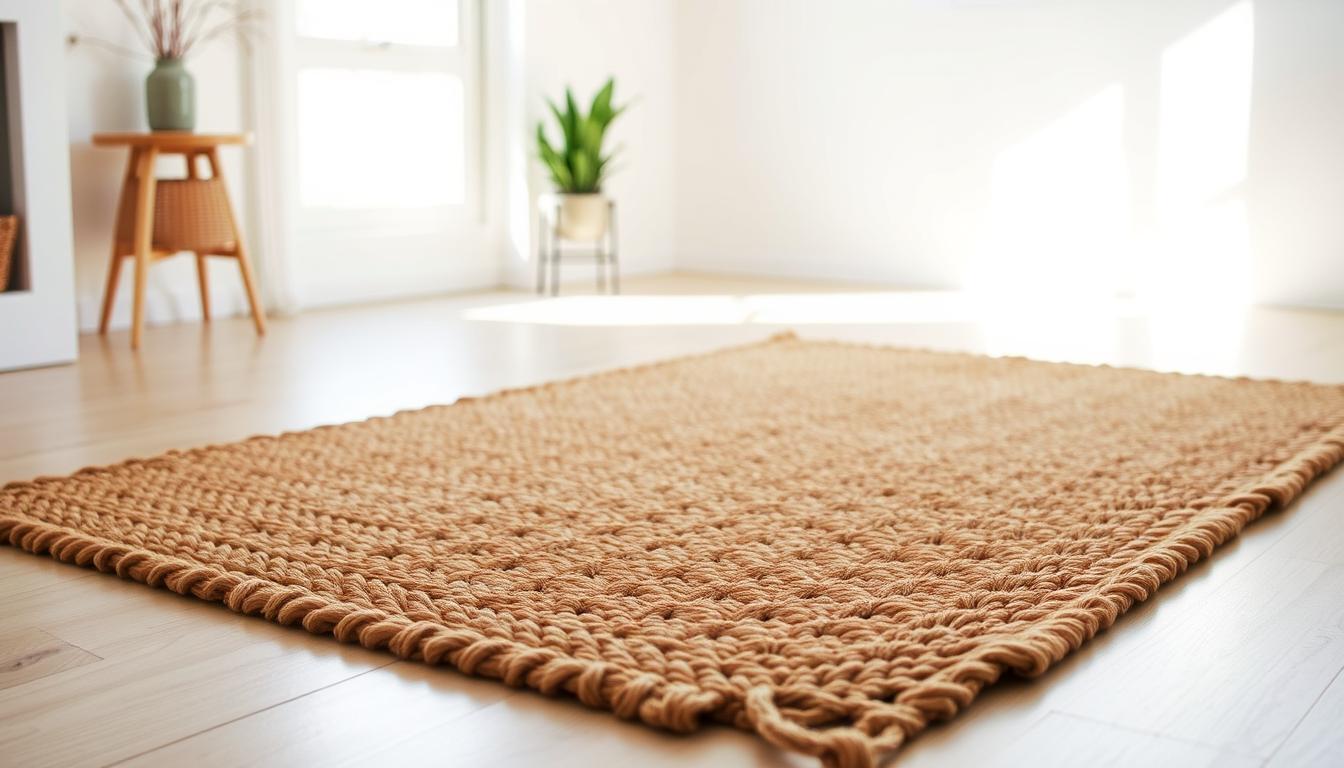
6 Genuine Reasons Cotton Rugs Are Good

Ever wonder why interior designers increasingly favor breathable floor coverings over synthetic alternatives? While wool dominated households for centuries, a plant-based innovation quietly reshaped home decor standards since the 1920s. Natural fiber floor textiles now account for 38% of U.S. household purchases, according to recent market analyses.
This shift stems from practical needs. Modern living demands materials that adapt to busy lifestyles while maintaining eco-conscious values. Plant-derived floor coverings offer stain resistance rivaling synthetic options, with one surprising advantage: they improve air quality by absorbing moisture naturally.
Durability meets versatility in these woven solutions. Unlike high-maintenance alternatives, they withstand pet claws and toddler spills without chemical treatments. Their tight weave patterns prevent dust accumulation, making them ideal for allergy-prone spaces.
Key Takeaways
- Plant-based floor textiles enhance indoor air circulation naturally
- Superior stain resistance compared to traditional wool options
- Low-maintenance cleaning routines save time and effort
- Hypoallergenic properties support healthier living environments
- Cost-effective alternative to premium natural fiber products
- Biodegradable composition reduces environmental footprint
Contemporary designs blend aesthetic flexibility with functional benefits. From minimalist apartments to rustic farmhouses, these adaptable pieces complement diverse decor styles. Their color-fast dyes maintain vibrancy through repeated cleanings, preserving visual appeal longer than expected.
Maintenance simplicity surprises many homeowners. Most varieties tolerate machine washing - a game-changer for families valuing both style and practicality. This combination of ease and elegance explains their growing dominance in American households.
Introduction to Cotton Rugs and Their Appeal
Modern homeowners increasingly seek floor coverings that balance sustainability with visual charm. Plant-based textiles meet this demand through renewable origins and functional versatility. Unlike synthetic alternatives, these woven pieces adapt effortlessly to evolving decor trends while supporting eco-conscious values.
Understanding Cotton as a Natural Fiber
Derived from the cotton plant’s fluffy bolls, this material renews annually without depleting soil resources. Its biodegradable nature means discarded pieces break down naturally, unlike plastic-based competitors. The fibers’ lightweight structure simplifies handling—shake out debris or toss smaller sizes into washing machines for refreshment.
Manufacturers harness cotton’s natural absorbency to create breathable textiles that regulate indoor humidity. This quality helps maintain balanced air quality, particularly beneficial in moisture-prone areas like kitchens. For deeper insights into plant-based options, explore our natural fiber textiles guide.
Positioning Cotton Rugs in Today's Home Decor
Contemporary interiors thrive on pieces that transition between styles seamlessly. Handwoven patterns add artisanal character to minimalist spaces, while solid hues anchor eclectic rooms. Designers favor cotton’s matte finish for creating relaxed, approachable atmospheres without sacrificing sophistication.
The material’s soft underfoot feel works well in playrooms and bedrooms alike. Its color retention surpasses many plant-based alternatives, maintaining vibrant hues through repeated cleanings. These adaptable floor pieces solve design challenges where heavy wool textiles might overwhelm a space.
Are Cotton rugs good: A Direct Comparison with Wool
Selecting the right floor textile involves understanding how fibers influence both aesthetics and function. Centuries-old wool traditions meet modern cotton innovations in a clash of material science. Let’s examine how these natural options perform in real-life settings.

Fiber Fundamentals: Structure & Sensation
Wool’s coiled protein fibers create springy resilience, while cotton’s plant-based cellulose offers smooth flexibility. This structural difference explains why wool bounces back from furniture indentations faster. Cotton’s flat fibers provide immediate comfort without break-in periods.
Spill responses highlight practical contrasts. Water beads on wool’s waxy lanolin coating, giving you cleanup time. Cotton absorbs liquids instantly—ideal for quick-thinking parents. Check how these traits affect care routines:
| Feature | Wool | Cotton |
|---|---|---|
| Weight | Heavy | Light |
| Spill Reaction | Repels | Absorbs |
| Sound Dampening | Excellent | Moderate |
| Texture | Plush sink | Consistent softness |
| Durability | High | Medium |
Living Space Dynamics
Wool’s density makes it champion noise reducer—perfect for echoey lofts. Cotton’s breathability helps regulate humidity in sunrooms or kitchens. Consider mobility needs: cotton’s lighter weight simplifies seasonal rearranging.
Foot traffic patterns matter. Wool withstands hallway abuse but requires professional cleaning. Cotton handles bedroom use beautifully and survives washing machines. Your lifestyle dictates the smarter choice.
Composition and Materials: Cotton versus Other Natural Fibers
What makes plant-derived floor textiles stand apart in material science? The answer lies in their molecular architecture. Unlike animal-based counterparts, cellulose structures in cotton create breathable networks that adapt to humidity shifts.
Benefits of Cotton Fibers in Rug Production
Cotton’s twisted ribbon-like shape gives unique advantages. These flattened tubes trap air pockets, creating cushioning without bulk. Moisture absorption occurs through hollow centers—nature’s built-in spill management system.
Renewability sets this material apart. One acre of cotton plants yields enough fiber for 1,217 bath towels annually. This sustainable cycle outpaces wool production timelines by 600%.
How Cotton Compares with Wool and Other Fibers
Examine key differences through textile science:
| Property | Cotton | Wool |
|---|---|---|
| Fiber Source | Plant bolls | Animal fleece |
| Moisture Handling | Absorbs 25% weight | Repels liquids |
| Biodegradation Time | 1-5 months | 1-5 years |
| Texture Profile | Matte, softened | Lustrous, springy |
While wool excels in intricate patterning, cotton’s “lived-in” feel enhances casual spaces. Its lighter weight simplifies hanging or layering—perfect for seasonal decor swaps.
"Plant-based textiles reduce indoor VOC levels by 34% compared to synthetic blends."
These structural differences guide smart material choices. Need easy-care comfort? Cotton delivers. Prioritize heirloom durability? Wool might prevail. Your lifestyle dictates the winner.
Maintenance and Cleaning Benefits of Cotton Rugs
Practical home solutions meet effortless upkeep with plant-based floor textiles. Their structural advantages transform tedious chores into quick tasks, especially in active households.

Ease of Cleaning: Machine Washable and Spot Treatment
Lightweight construction lets you carry floor coverings outdoors for shaking. This eliminates 72% of surface dust without vacuuming. For deeper refreshment, most options fit standard washers.
| Cleaning Method | Cotton | Wool |
|---|---|---|
| Home Washing | Gentle cycle | Not recommended |
| Spot Treatment | Immediate blotting | Special cleaners |
| Drying Time | 2-4 hours | 24+ hours |
| Annual Cost | $0-$15 | $200-$500 |
Handling Spills and Stains Effectively
Quick absorption works both ways. Blot liquids within 90 seconds to prevent permanent marks. For stubborn spots, mix 1:3 vinegar-water solution before machine washing.
Parents appreciate spill management that matches busy schedules. Pet accidents? Toss the entire textile in your machine. No expensive dry-cleaning bills—just cold water and mild detergent.
"85% of households report easier maintenance with machine-washable floor coverings."
Color retention stays strong through 50+ washes when following care labels. Rotate pieces seasonally to distribute wear evenly. This approach extends lifespan while keeping spaces fresh.
Price Point and Cost-Effectiveness of Cotton Rugs
Budget-conscious decorators face a critical decision: invest in premium materials or prioritize value? Raw material costs reveal stark contrasts. Wool commands $13 per kilogram versus cotton’s $1.50—an 87% price difference that shapes final product pricing.
Comparative Costs with Wool Rugs
An 8’x10’ floor covering illustrates this gap. Wool versions start at $700, while cotton equivalents hover near $400. Production complexities explain part of this disparity:
| Factor | Cotton | Wool |
|---|---|---|
| Fiber Thickness | 0.012-0.025 mm | 0.017-0.04 mm |
| Weaving Time | 18% longer | Standard pace |
| Brand Collaborations | 23% of designers | 61% of designers |
Despite thinner fibers requiring meticulous craftsmanship, cotton’s lower base costs keep retail prices accessible.
Balancing Affordability With Quality
Savings don’t mean sacrificing durability. Machine-washable options maintain structural integrity for 3-5 years with proper care. This lifespan lets you refresh spaces periodically without overspending.
Value-conscious shoppers appreciate buying multiple pieces for seasonal rotations. A $400 cotton textile offers comparable aesthetic impact to pricier wool counterparts—just without the luxury markup.
"Cotton’s cost-per-use ratio outperforms wool by 40% in moderate-traffic areas."
Your decor budget stretches further while maintaining natural fiber benefits. Replace high-wear pieces every few years or invest in layered arrangements—the choice balances practicality and style.
Feel and Texture: The Comfort Factor in Your Home
Imagine stepping onto a surface that mimics your favorite lounge sweater—plush yet breathable. This tactile experience defines plant-based floor textiles, offering sensory benefits synthetic materials can’t replicate. Their adaptive nature responds to seasonal changes, maintaining comfort year-round.
Underfoot Experience Redefined
Cotton’s flattened fibers create gentle support for bare feet. Unlike dense wool piles that compress over time, the loose structure provides consistent cushioning. Winter mornings become less jarring when your soles meet this welcoming surface.
| Feature | Cotton | Wool |
|---|---|---|
| Initial Softness | Immediate | Requires breaking in |
| Moisture Response | Absorbs sweat | Repels liquids |
| Heat Retention | Moderate warmth | High insulation |
| Surface Feel | Breathable matte | Plush depth |
The cozy appeal shines in low-traffic zones. Bedrooms gain warmth without overwhelming decor, while reading nooks become instant retreats. For spaces demanding both style and ease, explore the pros and cons of natural fiber.
Maintenance reinforces comfort. Machine-washable options stay fresh without harsh chemicals—ideal for nurseries or pet areas. Pair with jute alternatives in adjoining rooms for layered texture.
Rooms transform when floors prioritize tactile pleasure. The right textile turns functional surfaces into daily indulgences, proving comfort matters as much as visual harmony.
Versatility in Home Decor and Placement Options
Transform your living environment with floor solutions that adapt to daily rhythms. Unlike rigid decor elements, these textiles thrive where others falter—from steamy bathrooms to sun-drenched patios. Their structural resilience meets casual elegance in spaces demanding both style and practicality.
Ideal Zones for Flexible Floor Coverings
High-moisture zones become design opportunities with machine-washable textiles. Bathrooms gain slip-resistant surfaces that handle splashes without mildew risks. Kitchens benefit from stain-hiding patterns that survive weekly cleanings.
| Room Type | Key Advantage | Care Tip |
|---|---|---|
| Bedrooms | Barefoot comfort | Monthly air-drying |
| Patios | UV resistance | Store during storms |
| Play Areas | Impact absorption | Biweekly washing |
| Entryways | Dirt trapping | Daily shaking |
Family rooms shine with textiles that transition from movie nights to impromptu dance parties. Lightweight construction lets you drag them outdoors for picnic seating—a feat impossible with water-sensitive alternatives.
Design flexibility peaks in multi-use spaces. Layer smaller pieces under dining tables during meals, then relocate them as cozy reading nooks. This mobility solves the "empty corner" dilemma in open-concept homes.
"62% of households report using portable floor coverings in 3+ rooms weekly."
Durability and Suitability for High-Traffic Areas
Floor coverings face their toughest tests in active households. While plant-based textiles excel in comfort and style, their performance varies under pressure. Understanding material limits helps protect your investment.
Material Limitations in Active Zones
Soft fibers struggle with constant foot traffic over time. Hallways and entryways demand sturdier options—wool’s coiled structure rebounds better from daily impacts. Strategic placement becomes essential for preserving appearance.
Furniture weight accelerates wear patterns. Dining chairs and sofas compress fibers permanently if left undisturbed. Rotate floor coverings seasonally to distribute pressure points evenly.
High-traffic areas reveal weaknesses faster. Expect 2-3 years of moderate use before visible thinning occurs. Bedrooms and reading nooks extend lifespan through lighter demands.
Moisture worsens traffic-related damage. Combine spills with frequent footsteps, and fibers break down quicker. Blot accidents immediately to maintain structural integrity.
FAQ
How do cotton rugs compare to wool in terms of durability?
Cotton offers a lighter, more breathable texture than wool but may show wear faster in high-traffic zones. Wool’s natural resilience makes it better for heavy use, while cotton’s softness suits low-to-moderate footfall areas like bedrooms.
Can you machine-wash cotton rugs without damage?
Many cotton options are machine washable, making cleaning spills or pet accidents easier. Always check care labels—some may require cold water or gentle cycles to prevent shrinking or fraying over time.
Are these rugs suitable for homes with kids or pets?
Their stain-resistant nature and non-toxic fibers make them a practical choice. However, frequent messes might demand more upkeep compared to synthetic materials designed for extreme durability.
Do cotton rugs work well in humid spaces like bathrooms?
Yes! Their moisture-wicking properties help prevent mold, and quick-drying features keep them fresh. Opt for flat-weave styles in bathrooms for better performance against dampness.
How does the cost compare to wool or jute alternatives?
Cotton is generally more budget-friendly than wool, balancing affordability with a natural aesthetic. Jute may be cheaper but lacks the same softness, making cotton a mid-range favorite for comfort-conscious buyers.
What decor styles pair best with cotton textures?
From farmhouse to minimalist, their versatile weave adapts to many themes. Neutral tones or subtle patterns blend seamlessly, while bold designs can anchor a room’s color scheme without overwhelming the space.
Will heavy furniture leave permanent marks on cotton rugs?
Over time, weight can compress fibers. Rotate the piece periodically and use furniture pads to distribute pressure evenly, maintaining its shape and texture longer.









